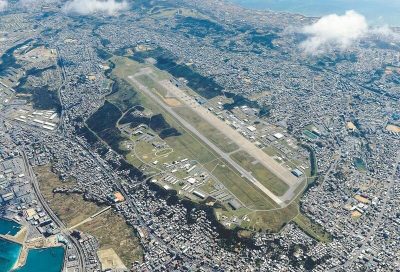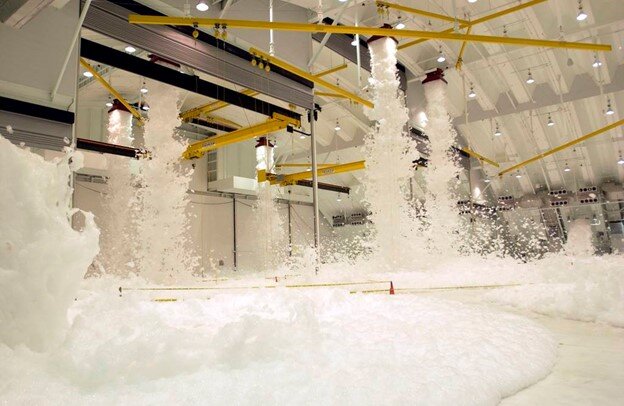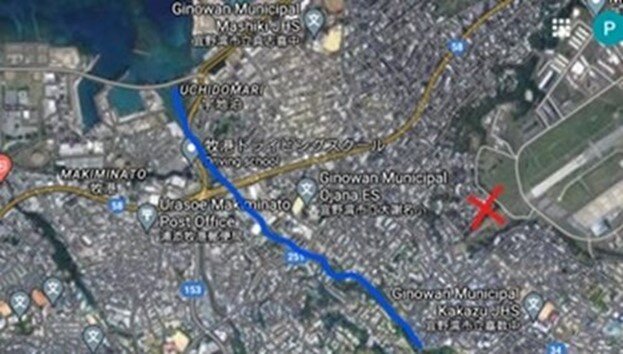Caught Between a Rock and a Hard Place: U.S. Marines in Okinawa Discharge PFAS into the Sewers
Okinawan officials are “furious” while the Japanese government is complacent

All Global Research articles can be read in 51 languages by activating the “Translate Website” drop down menu on the top banner of our home page (Desktop version).
Visit and follow us on Instagram at @crg_globalresearch.
***
Recent history of contamination
In 2020 the Futenma Marine Corps Command was forced to cancel the popular, annual Futenma Flightline Fair that had been scheduled for Saturday, March 14 and Sunday, March 15. These were the early days of the Covid pandemic and everyone looked forward the Flightline Fair and the displays of the F/A-18’s, F-35B’s and MV-22’s, with flyovers, a car show, and a spectacular barbecue.
Morale suffered, so the command gave the nod to hold a barbecue on April 10th near a large hangar for the esprit de corps of the Marines. Heat from the barbecue equipment triggered the hangar fire suppression system, releasing massive amounts of toxic firefighting foam containing Perfluoro octane sulfonic acid, (PFOS). It ruined the barbecue. Futenma Flightline Fair – Koji Kakazu Photography
Hundreds of mishaps like this have been documented at U.S. military bases worldwide since the early 1970’s when the carcinogens were first used in the firefighting foams. Sometimes the overhead foam suppression systems are triggered accidentally during maintenance. Sometimes, they activate from incidental smoke and or heat. It’s a common occurrence.
When the suppression systems unleash their foams, the military may either send the foam into storm water sewers, sanitary sewers, or underground storage tanks. Sending the carcinogens into the storm water sewers causes the materials to run directly into the rivers. Discharging the foams into the sanitary sewer system means the toxins are sent to wastewater treatment facilities where they are eventually discharged, untreated, into the rivers. Foams captured in underground storage tanks can be sent to either of the sewer systems or removed from the site to be dumped elsewhere or incinerated. Because the chemicals don’t burn and don’t break down, there is no way to properly dispose of them and they’re likely to find pathways to human consumption. The Okinawans are upset for this reason.
ANDERSEN AIR FORCE BASE, Guam — Foam from a fire suppression system sprays from the walls and ceiling inside a newly built aircraft maintenance hangar during a test and evaluation exercise in 2015. (U.S. Air Force photo)
During the April 10, 2020 barbecue incident, 227,100 liters of the foam were released, of which more than 143,800 liters leaked out of the base and, presumably, 83,300 liters were sent to underground storage tanks.
The foam covered a local river and cloud-like formations of foam floated more than a hundred feet above the ground, settling in residential playgrounds and neighborhoods. David Steele, commander of Futenma Air Base, further alienated the Okinawan public when he said, “If it rains, it will subside.” Apparently, he was referring to the foamy bubbles, not the propensity of the foams to sicken people. A similar accident occurred on the same base in December of 2019 when the fire suppression system accidentally discharged the carcinogenic foam.
April 17, 2020 – U.S. Marine Corps Col. David Steele, commanding officer of Marine Corps Air Station Futenma, meets with Okinawa Vice-Gov. Kiichiro Jahana where firefighting foam was captured in an underground storage tank. (U.S. Marine Corps photo)
In April, 2020, the foamy water flowed out of stormwater pipes (red x) from the Marine Corps Air Station Futenma. The runway is shown on the right. The Uchidomari River (in blue) carries the toxins to Makiminato on the East China Sea.
The commander of U.S. Forces in Japan, Lt. Gen. Kevin Schneider, released the following statement, on April 24, 2020, two weeks after the incident, “We regret this spill and are working hard to find out why it happened in order to ensure an event like this does not happen again. However, I am very pleased with the level of cooperation we have seen at the local and national levels as we clean this up and work to manage the global challenge presented by these substances,” said Schneider.
This is a boilerplate response used worldwide to placate the locals, whether they’re in Maryland, Germany, or Japan. The military knew immediately why it happened. They understand accidental releases will continue to occur and imperil human health.
The Americans rely on subservient host governments. For instance, a report by the Okinawa Defense Bureau, the local branch of the Japanese Ministry of Defense, said that the foam releases at Futenma “had almost no effect on humans.” However, the Ryuko Shimpo newspaper sampled river water near the Futenma base and found 247.2 parts per trillion (ppt) of PFOS/PFOA in the Uchidomari River. Seawater from Makiminato fishing port contained 41.0 ng/l of the toxins. The river had 13 varieties of PFAS that are contained in the military’s aqueous film-forming foam (AFFF). To put these numbers into perspective, the Wisconsin Department of Natural Resources says surface water levels that exceed 2 ppt pose a threat to human health. The PFOS in the foams wildly bioaccumulate in aquatic life. The primary way people consume these chemicals is by eating fish.
Okinawan Governor Denny Tamaki was outraged. He said, “I truly have no words,” when he learned that a barbecue was the cause of the release. In early 2021, the Okinawan government announced that groundwater in the area around the Marine Corps base contained a concentration of 2,000 ppt of PFAS.
In Okinawa, the public and the press are increasingly exasperated by the insolence of the U.S. military. The word is being passed around that the U.S. military is poisoning millions of people around the world and is intent on continuing to do so. More than 50,000 individuals in the U.S., who operate farms within a mile of military installations, are expected to receive notification from the Pentagon that their groundwater is likely to be contaminated with PFAS. The potentially lethal underground plumes from the fire training areas on base may actually travel 20 miles.
These toxic releases and the wholesale poisoning of millions of Americans will top the Pentagon’s public relations fiascos of My Lai, Abu Ghraib, and the slaughter of 10 Afghan civilians we recently witnessed. About 56 percent of Americans surveyed earlier this year said they have “a great deal of trust and confidence” in the military, down from 70 percent in 2018. We’ll witness this trend accelerate while news outlets are forced to cover the military’s poisoning of America and the world. There’s a deep irony in all of this. The antiwar movement and mainstream environmental groups in the United States have generally been slow to embrace the issue. Instead, the insurgency will arise from farmers in middle America.
August 26, 2021
A new chapter of American imperial arrogance in Okinawa unfolded on August 26, 2021. Neither the U.S. nor the Japanese have developed standards regarding the levels of PFAS that may be released into sanitary sewer systems. It seems both nations are fixated on the drinking water while the science is clear and irrefutable that most of the PFAS consumed by humans is through the food we eat, especially seafood from contaminated waters.
The military command at Futenma met with Japanese central government and Okinawan prefectural officials on July 19, 2021 to collect samples of treated water from the base to conduct separate tests. A followup meeting was set for August 26th to discuss plans to release the results of the three tests.
Instead, on the morning of August 26th, the Marines unilaterally and maliciously dumped 64,000 liters of the poisoned water into the municipal sewer system. The water came from the underground tanks that contained the spilled firefighting foam. The Marines still have approximately 360,000 liters of contaminated water remaining on base, according to the Asahi Shimbun newspaper.
Okinawan officials say they received an email at 9:05 a.m. on Aug. 26 from the Marines saying water containing the toxins would be released at 9:30 a.m. The U.S. military said the water released contained 2.7 ppt of PFOS per liter of water. The U.S. military had expressed concern that the storage tanks could overflow due to heavy rain brought by typhoons, while the Japanese Ministry of Defense stated that the transfer of the water is “an emergency interim measure due to the typhoon problem.”
Ginowan city officials reacted immediately. Just two hours after the discharge began, the Ginowan Sewage Facility Division took wastewater samples from a manhole in the Isa area, where MCAS Futenma’s wastewater meets the public system.
The sample showed the following concentrations:
- PFOS 630 ppt
- PFOA 40 ppt
- PFHxS 69 ppt
- Total 739 ppt
The U.S. Marines reported finding 2.7 ppt of PFAS in the sewer water. The Okinawans say they found 739 ppt. Although routine testing of PFAS in various media can detect 36 analytes, only the three above have been reported by the Okinawans. The Marines simply reported “2.7 ppt of PFOS.” It is likely the overall totals of all PFAS concentrations would be twice the 739 ppt if the other varieties of PFAS had been tested.
The Okinawa prefectural (state) and Ginowan municipal governments immediately lodged protests with the U.S. military. “I feel strong outrage that the U.S. military unilaterally dumped the water even while they knew that discussions were proceeding between Japan and the United States on how to handle the contaminated water,” Okinawa Governor Denny Tamaki said later that day. .
It is instructive to compare the responses of the Ginowan City Council, The Okinawan prefecture, the Marine Corps Installations Pacific, Okinawa, and the government of Japan.
On September 8th, the Ginowan City Council adopted a resolution saying it was ”furious” with the U.S. military for the disposal of the contaminated water. The city had previously asked the Marines not to dump the poisons into the sanitary sewer system. The resolution called on the U.S. military to switch to firefighting foams that do not contain PFAS and demanded the U.S. military incinerate the materials. The city’s resolution said the release of chemicals “shows a complete disregard for the people of this city.” Ginowan Mayor Masanori Matsugawa said, “It is extremely regrettable because the release of the water lacked any consideration for local residents who still have not erased their concerns” from last year’s incident. Okinawa’s Governor, Denny Tamaki says he wants access to the Futenma base to conduct independent testing.
The U.S. military responded to the city council’s resolution the next day by circulating a misleading press release with the following headline:
Marine Corps Installations Pacific Removes
All Aqueous Film Forming Foam (AFFF) on Okinawa
The text of the military propaganda piece says the Marine Corps has “completed the removal of all legacy Aqueous Film Forming Foam (AFFF) from Marine Corps camps and installations on Okinawa.” The Marines explained that the foams containing PFOS and PFOA had been shipped to mainland Japan to be incinerated. The foams have been replaced “with a new foam which meets Department of Defense requirements and which still provides the same life-saving benefits in the event of a fire. This action significantly reduces the environmental risk posed by PFOS and PFOA on Okinawa and is another concrete demonstration of MCIPAC’s transparency and its strong commitment to environmental stewardship.”
The DOD removed firefighting foams containing PFOS and PFOA from its U.S. bases several years ago while they’re only doing so now, under pressure, in Okinawa. The new PFAS foams likely include the PFHxS found in Okinawa’s water, are also toxic. The DOD refuses to disclose exactly what PFAS chemicals are present in its firefighting foams, because “the chemicals are the proprietary information of the manufacturer.”
PFHxS is known to induce neuronal cell death and has been associated with early onset menopause and with attention deficit/hyperactivity disorder in children.
The Okinawans are outraged; the Marines are lying, while the Japanese government is complacent. Yoshihide Suga, Prime Minister of Japan, said the Japanese government, carried out a thorough investigation of the incident. He said the government of Japan is urging U.S. forces to replace firefighting foams containing PFOS. Nothing more.
To recap, the Americans reported 2.7 ppt of PFAS in the sewage effluent while the Okinawans found 274 times that amount in the sewer water. The Okinawans are caught between a rock and a hard place.
Stars and Stripes reported on September 20th that the Japanese government has agreed to take over “disposal” of Futenma’s contaminated wastewater. The government has agreed to pay $825,000 to incinerate the materials. The U.S. military escapes justice.
Governor Tamaki called the development a step forward.
Incineration is not a step forward! The Japanese government and Okinawan officials are apparently unaware of the dangers inherent in incinerating PFAS. There is no scientific evidence that incineration destroys the deadly chemicals in the firefighting foam. Most incinerators are incapable of reaching the temperatures necessary to destroy the fluorine-carbon bond characteristic of PFAS. These are, after all, firefighting foams.
The EPA says it’s not sure if PFAS is destroyed through incineration. The temperatures required to destroy the compounds exceed the temperatures reached by almost all incinerators.
On September 22nd the U.S. House of Representatives passed an amendment to the Fiscal Year 2022 National Defense Authorization Act that establishes a moratorium on the incineration of PFAS. The measure will be voted on by the Senate as it considers the massive funding package.
Governor Tamaki, you’ve been great on this! Please correct the record. The incinerators will sprinkle a silent death over Japanese homes and farms.
Protesters in Okinawa play a crucial role in shaping the narrative. Unlike the states, the mainstream press seriously reports their message. They’re not dismissed as riff raff on the street. Rather, they’re recognized as a legitimate electric current that courses through the citizenry.
In a protest letter to the Japanese Minister of Defense and the Okinawan Defense Bureau, Co-representatives Yoshiyasu Iha, Kunitoshi Sakurai, Hideko Tamanaha, and Naomi Machida of the Liaison Committee to Protect Citizens’ Lives from Organic Fluorocarbon Contamination makes three demands:
1. An apology from the US military for its environmental crimes, particularly the deliberate release of water contaminated with PFAS into public sewers.
2. Prompt on-site investigations to determine the source of pollution.
3. All treatment and costs for detoxifying PFAS contaminated water from the Futenma base should be borne by the U.S. military.
Contact: Toshio Takahashi [email protected]
What we’re witnessing in Okinawa is occurring world-wide, although many are unaware of this pressing public health issue due to a general press embargo. This is starting to change.
*
Note to readers: Please click the share buttons above or below. Follow us on Instagram, @crg_globalresearch. Forward this article to your email lists. Crosspost on your blog site, internet forums. etc.
Featured image: U.S. Marine Corps Air Station Futenma is located in densely populated Ginowan City, Okinawa.





